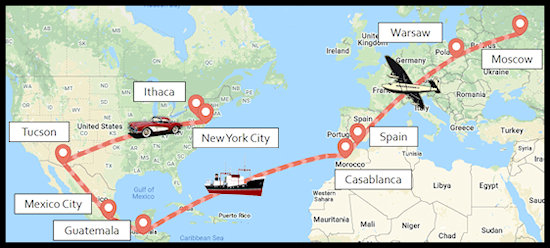On November 11, 1944, encrypted communications from Soviet intelligence intercepted by the FBI indicated that Alfred Sarant, a civilian engineer working at U.S. defense contractors, had been recruited as a spy; the message also set forth procedures for the transmission of U.S. military secrets being used by this organized espionage ring.
During World War II, at military bases such as the U.S. Army Signal Corps facilities at Fort Monmouth, the FBI had begun to more aggressively seek to identify Communist Party members or sympathizers who held sensitive positions in government, including jobs that afforded routine access to classified military information. Eventually, the FBI cracked the Soviet code, and they soon knew spies such as Sarant were at work. They began to work diligently to identify the mysterious figures referenced in coded messages.
In February of 1945, Julius Rosenberg was fired by the Signal Corps for his past communist activities. Within two weeks, he was hired by Emerson Radio and Phonograph Corporation, a defense contractor where he had previously stolen Signal Corps secrets while working as a field inspector for the Army. He eventually was fired again as a security risk, and at this time set up a machine shop business with his brother-in-law David Greenglass, and others, as a front in New York City, and continued transmitting stolen military secrets from a pair of Greenwich Village apartments used for microfilming.
Joel Barr left Western Electric in September 1945, and spent the next year studying for his master’s degree in engineering at Columbia University. In October of 1946, he moved to a new job with Sperry Gyroscope, another defense contractor working on technologies developed by the Signal Corps Laboratories at Fort Monmouth. In October of 1947, FBI investigators caught up with Barr, and he was fired by Sperry Gyroscope for being a security risk. The U.S. chose not to prosecute Barr at that time because a court case would force disclosure that the U.S. had cracked Soviet codes before the FBI had identified all of the spies referred to in intercepted transmissions.
Barr quickly moved to Europe where he studied electronics in Sweden and Norway, and music in Paris. He spent four months in Finland, playing piano to pay the bills, hoping to study with the legendary composer Jean Sibelius, but they never connected. He returned to Paris to study the viola.
In October of 1946, with the war over, Alfred Sarant moved to Ithaca, N.Y., where he initially worked at Cornell University in the physics laboratories, helping in construction of a cyclotron. By December of 1946, married, with a newborn son and a newly launched home construction business, Alfred Sarant was now “out of the espionage business.”
On June 16, 1950, the FBI cracked the Manhattan Project spy ring and connected Julius Rosenberg to other co-conspirators. But the KGB was well aware that the FBI had already broken the Soviet code. No less than legendary British MI6 traitor and spy Kim Philby, assigned to be an intelligence liaison with U.S. intelligence, was briefed on a regular basis by the FBI on their Soviet intelligence intercepts. The bureaucracy and internecine rivalry that characterized the relationship of the FBI and CIA at that time is such that the KGB knew the FBI was reading their mail ten years before the CIA did.
Thanks to Philby, on June 17, 1950, the day after the FBI identified Rosenberg as a spy, the KGB moved Joel Barr from Paris to Prague, Czechoslovakia. U.S. officials raced to have Paris consular staff try and find Barr at his last known address, but he had already left, leaving behind his clothes, motorcycle and personal possessions. In Prague, Barr was given a new identity: Josef V. Berg. Joel Barr effectively vanished.
The same day Joel Barr fled Paris, July 17, 1950, Julius Rosenberg was arrested on suspicion of espionage. On July 19, 1950, two days after Rosenberg’s arrest, the FBI sent two agents from its Albany office to Ithaca to interview Alfred Sarant. He agreed to answer their questions, and allowed them to search his home. The two agents spent a week interrogating Sarant, accusing him of being an active member of the Communist Party. They also accused Sarant of keeping an apartment in New York City at 65 Morton St., #6-I, for espionage purposes. Sarant protested that he was innocent. As he was cooperative and with a young family, Sarant did not seem to be a risk of flight, so the FBI did not arrest him, although it possessed decrypted KGB cables that clearly identified him as a member of the Rosenberg ring.
On July 26, 1950, feeling the FBI closing in, Sarant ran away with Carol Dayton, a graduate student at Cornell and the wife of his close friend and neighbor, Bruce Dayton; Sarant and Dayton both abandoned their children and spouses and fled initially to New York City. It would later come to light that both had been unhappy in their respective marriages for some time. By the time they left, they had already admitted the affair to their spouses.
On August 4, 1950, Sarant and Dayton left New York City and made a “mad dash” by car across the country to Tuscon, Ariz., where Dayton had relatives. On August 9, 1950, Sarant and Dayton crossed over into Mexico.
The couple eluded Mexican police and contacted Polish trade representatives in Mexico City, on the belief that Soviet-bloc commercial development agencies were usually KGB fronts, and that approaching the Soviet embassy directly was too risky. Acting on Soviet orders, the Poles hid Sarant and Dayton for six months; the couple then drove south to Guatemala, where they waded a river to cross the border into a country that was in the middle of a government coup. From Guatemala, they boarded a cargo ship to Casablanca. The couple took another ship to Spain, where they were put on a flight to Warsaw, finally ending up in Moscow, 12,000 miles later. Sarant, like Barr, effectively vanished and became a mysterious fugitive for decades. Sarant never returned to the U.S.
Sarant was given a new identity, Filip Georgiyevich Staros. He and Dayton were stashed in a luxury apartment in Warsaw for six months, before being sent to Moscow, where they were surprised to be reunited with Joel Barr. Josef Berg (Barr) and Filip Staros (Sarant) were soon sent to Czechoslovakia, where they took on leadership positions working on Soviet defense technology systems.
On August 11, 1950, Ethel Rosenberg, Julius’s wife, was arrested on charges of espionage related to the Manhattan Project atomic bomb research. She and Julius were tried, convicted, and were executed via the electric chair at New York State’s Sing Sing Correctional Facility in Ossining, N.Y., on June 19, 1953.
Controversy over the value of the atomic bomb secrets that the Rosenbergs helped transmit to the USSR has obscured the tremendous value of the information about conventional weapons systems that he and Barr and Sarant stole from the Signal Corps and its defense contractors. They provided detailed specifications for radio, radar, the proximity fuse, the Norden bombsight, and other important military technologies developed during World War II and, in the process, helped the Soviet Union lay the foundation for a defense industry that maintained rough parity with the United States throughout the Cold War.
So, there were indeed communist spies who had infiltrated the U.S. Army Signal Corps at Fort Monmouth, from 1942-1945. But by 1946, these spies had scattered and the ring no longer existed within the Army Signal Corps or its defense contractors. And yet, the question of spies at Fort Monmouth was about to become front-page news all over again. But this time, the question was, were there any new spies at Fort Monmouth? Or were there members of the old Rosenberg ring who were still there, and who had evaded detection? Wisconsin Senator Joseph McCarthy certainly believed this to be true, and his allegations would have far-reaching effects on the people of Fort Monmouth.
SOURCES:
BIG ROLE IN SOVIET COMPUTERS LAID TO ROSENBERG ASSOCIATE. (1983). Associated Press in The New York Times, September 19, 1983, Section B, P. 14. Available: https://www.nytimes.com/1983/09/19/us/big-role-in-soviet-computers-laid-to-rosenberg-associate.html?searchResultPosition=2
Kling, Andrew A. (2012). The Red Scare. Lucent Books, A part of Gale, Cengage Learning. Gale eBooks. Available: https://link.gale.com/apps/doc/CX2349300001/GVRL?u=monmouth_main&sid=GVRL&xid=1d1118c3. (library membership required).
Locke, Michelle. (1992). Mexico trip turns into 40 years behind Iron Curtain. Associated Press, in The Press Democrat, Santa Rosa, Calif., August 16, 1992, P. 33.
Radosh, Ronald & Milton, Joyce. (1983). The Rosenberg File: A Search for the Truth. Holt, Rinehart and Winston, New York, N.Y.
Staff of the Historical Office. (2008). A History of Army Communications and Electronics at Fort Monmouth, New Jersey 1917-2007. Office of the Deputy Chief of Staff for Operations and Plans, U.S. Army CECOM Life Cycle Management Command, Fort Monmouth, N.J. U.S. Government Printing Office, available: bookstore.gpo.gov.
Usdin, Steven T. (2005). Engineering Communism: How Two Americans Spied for Stalin and Founded the Soviet Silicon Valley. Yale University Press, New Haven, Conn.
Usdin, Steven T. (2007). Tracking Julius Rosenberg’s Lesser Known Associates: Famous Espionage Cases. Central Intelligence Agency Library, April 15, 2007. Updated June 26, 2008. Available: https:/www.cia.gov/library/center-for-the-study-of-intelligence/csi-publications/csi-studies/studies/vol49no3/html_files/Rosenberg_2.htm
Map showing route and means used by Alfred Sarant when he fled the USA to Moscow created by John R. Barrows.


Leave a Reply